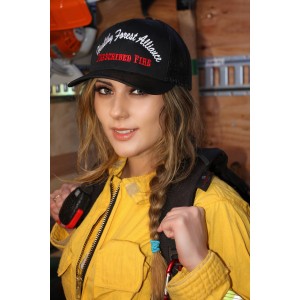"EMPOWERING EXCELLENCE, UNITING EXPERTISE: IGNITING TOMORROW'S FIRE PRACTITIONERS"
Fireline Tools and Equipment Resources
for the
California State Certified Burn Boss (CARX)
Equipment & Tools
Prescribed fire, also known as controlled burning, is a valuable tool in land management, forestry, and wildfire risk reduction. To safely and effectively execute prescribed burns, practitioners rely on a variety of specialized equipment designed to control fire behavior, mitigate risks, and ensure operational success. Here, we explore the essential equipment used in prescribed fire operations and their roles in facilitating safe and efficient burn operations.
1. Drip Torches: Drip torches are handheld devices used to ignite fires during prescribed burns. They consist of a fuel canister attached to a wick, which drips a mixture of diesel fuel and gasoline onto the ground to create a controlled ignition. Drip torches provide fire practitioners with the ability to start fires at specific locations and adjust flame intensity as needed, enabling precise control over burn operations.
2. Fire Rakes and Flappers: Fire rakes and flappers are hand tools used to manipulate burning vegetation and control fire spread. Fire rakes feature sharp teeth or tines for cutting and dragging fuel, while flappers consist of a flat paddle attached to a handle for smothering flames and extinguishing spot fires. These tools allow firefighters to create firebreaks, contain flames, and direct fire behavior during prescribed burns.
3. Backpack Water Pumps: Backpack water pumps, also known as Indian pumps or bladder bags, are portable firefighting pumps carried by firefighters to suppress spot fires and cool hotspots during prescribed burns. These lightweight pumps are typically powered by hand pumping or compressed air and can deliver a steady stream of water to extinguish flames and reduce fire intensity, enhancing safety and control on the fireline.
4. Handheld Weather Instruments: Handheld weather instruments, such as anemometers and Kestrel weather meters, are essential for monitoring weather conditions during prescribed burns. These devices provide real-time data on wind speed, direction, temperature, and humidity, enabling fire practitioners to assess fire behavior, predict fire spread, and make informed decisions about burn operations.
5. Fire Trucks and Water Tenders: Fire trucks and water tenders play a critical role in supporting prescribed fire operations by providing water, firefighting equipment, and personnel transport. Fire trucks are equipped with water tanks, hoses, and pumps for extinguishing spot fires and reinforcing fire lines, while water tenders transport large quantities of water to remote burn sites, ensuring adequate water supply for firefighting efforts.
6. Personal Protective Equipment (PPE): Personal protective equipment is essential for firefighter safety during prescribed burns. PPE includes items such as fire-resistant clothing, helmets, gloves, goggles, and respiratory protection (e.g., N95 masks), which protect firefighters from heat, flames, smoke, and airborne particles. Properly fitting and maintained PPE are essential for minimizing the risk of injury and ensuring the well-being of firefighters on the fireline.
Conclusion:
The equipment used in prescribed fire operations plays a crucial role in ensuring the safety, effectiveness, and success of burn operations. From ignition devices and firefighting tools to weather instruments and personal protective gear, each piece of equipment serves a specific function in controlling fire behavior, mitigating risks, and achieving management objectives. By equipping firefighters with the right tools and training, prescribed fire practitioners can confidently and responsibly utilize controlled burning as a valuable land management tool.
Mapping prescribed burns is an essential component of effective fire management strategies, aiding in planning, execution, and post-burn assessment. Fortunately, a plethora of resources are available to practitioners, offering diverse tools and techniques tailored to their needs.
Geographic Information System (GIS) software stands as a cornerstone in prescribed burn mapping. Platforms like ArcGIS, QGIS, and Google Earth Pro enable practitioners to overlay various spatial data layers, including vegetation types, fuel loads, and topography. These tools facilitate comprehensive burn planning and analysis, ensuring that burns are conducted safely and effectively.
Satellite imagery and remote sensing technologies provide invaluable insights into burn areas and their ecological impacts. Data sources like Landsat, Sentinel, and MODIS offer high-resolution imagery for detecting burn scars, assessing vegetation health, and monitoring post-burn recovery. By leveraging these resources, practitioners can track fire behavior and ecosystem dynamics over time.
Field mapping equipment plays a vital role in collecting real-time data during prescribed burns. GPS receivers, drones, and mobile devices equipped with mapping applications enable practitioners to capture accurate spatial information on fuel types, fire perimeters, and environmental conditions. This field data can then be integrated with GIS software for immediate analysis and decision-making.
Community mapping platforms foster collaboration and data sharing among practitioners, researchers, and stakeholders. Platforms such as OpenStreetMap and WildfireX facilitate crowd-sourced mapping of burn areas, ecological observations, and fire perimeters. By harnessing collective knowledge and expertise, practitioners can enhance the accuracy and comprehensiveness of prescribed burn mapping efforts.
Training resources and educational materials are also readily available to practitioners seeking to improve their mapping skills. Workshops, online courses, and tutorials provided by organizations and agencies specializing in fire management and geospatial technology offer valuable insights into mapping techniques and best practices.
In conclusion, the abundance of resources available to map prescribed burns empowers practitioners to make informed decisions and implement effective fire management strategies. By leveraging GIS software, satellite imagery, field mapping equipment, community platforms, and training resources, practitioners can ensure that prescribed burns are conducted safely, sustainably, and with minimal ecological impact.
-
Smoke Management
124 hits -
Fire Behavior
133 hits -
Weather
122 hits -
Mapping
104 hits -
Burn Permits
127 hits -
Prescribed Burn Planning
119 hits
-
CalTopo
2015 hits















